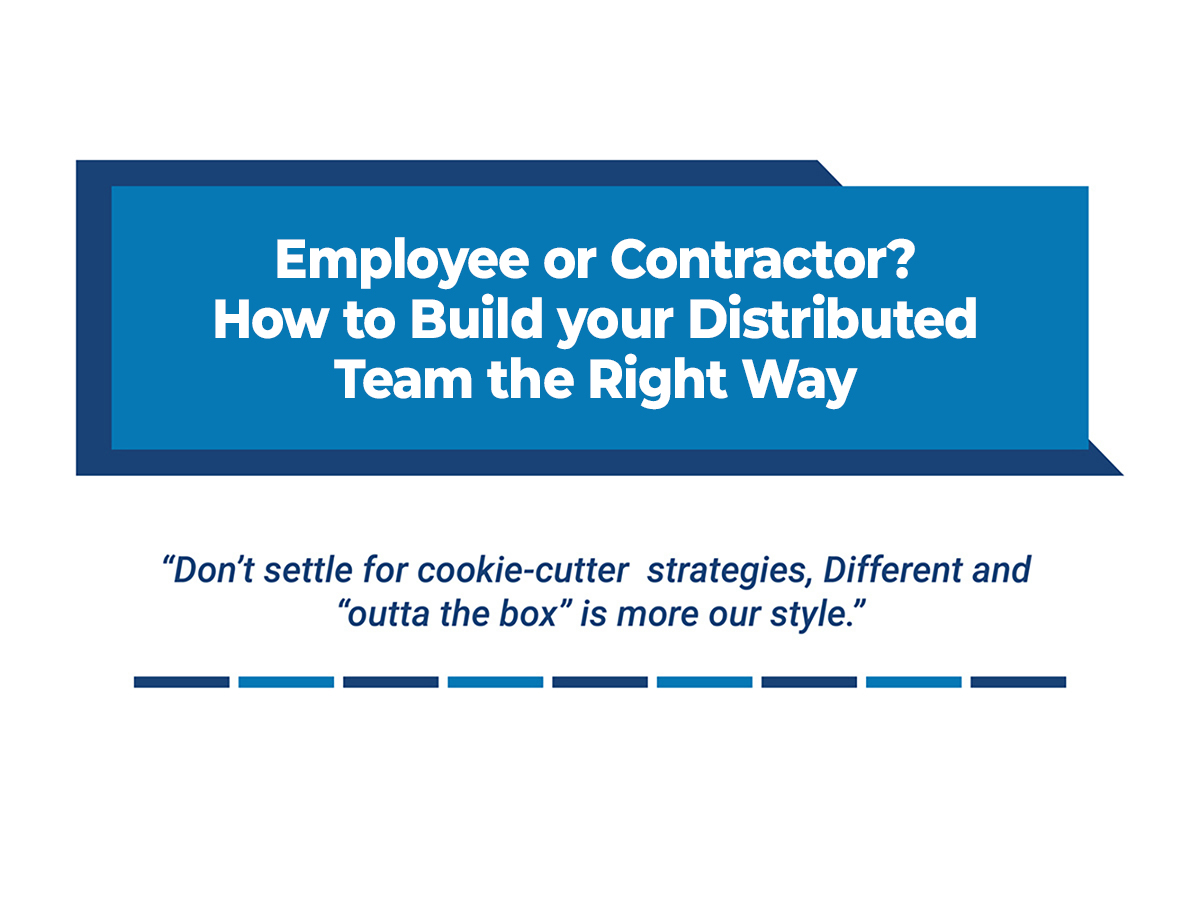Remote work is no longer a trend, or an idea. It’s here to stay, and building your distributed team the right way is fundamental for building your business success. A key decision you’ll need to make as you build your distributed team is your hiring structure. Choosing between an employee role or a contractor role is important. Your decision and chosen structure affects everything from legal compliance and tax obligations to team culture and long-term strategy.

Employee or contractor
When deciding how you’ll hire and place your distributed team, it’s important to understand the difference between hiring an employee and hiring a contractor. Employees are considered part of your business, and are subject to its control and direction. Employees receive regular salaries, benefits, and are protected by labour laws. Contractors, on the other hand, are independent entities who provide services to your business based on a contract. Contractors retain full control over their work methods, schedules, and often use their own equipment.
Employee benefits
If you opt to go the route of hiring employees, this can give your business the benefit of stability and control. As an employer, you have direct control over the employee’s work, processes, and adherence to company policies. This can be important for maintaining brand consistency and quality control. Hiring employees also helps you to build a stronger team culture. Employees are more likely to feel connected to the company culture and invested in its success. This builds a sense of loyalty and teamwork, which is essential for your long-term business growth. Integrating and onboarding an employee is also often easier, as they undergo and adhere to the same training, communication protocols, and performance management processes. Employee relationships are often more stable with lower staff turnover and reduced recruitment costs. As you invest in your employees’ career development, your business benefits too from their enhanced skills and expertise.
Employee concerns
Unfortunately, it’s not all roses when you choose to hire employees, as there can be some disadvantages. Hiring an employee may limit your business’ adaptability, especially in times of economic uncertainty. If your business faces some financial difficulties, it can result in higher costs for when you need to retrench staff. Similarly, going the employee route also involves significant expenses, including salaries, benefits, payroll taxes, and compliance with labour laws in different jurisdictions. As you’re hiring employees for your distributed team, you need to ensure that you can navigate different labour laws, tax regulations, payment standards, and other legal requirements. Managing payroll, benefits administration, and human resources processes for remote employees can be time-consuming. You’ll need robust and resilient systems and procedures to ensure your business can take on the burden of a full-time employee.
Contractor benefits
Hiring a contractor can greatly benefit your business, especially if you are concerned about retaining flexibility and adaptability. Contractors typically do not receive employee benefits, and you are not responsible for payroll taxes or employer contributions. This can significantly reduce your labour costs, especially for short-term projects or if your business is in need of specialised skills. Hiring a contractor gives your business much greater flexibility, when you need to scale up or scale down your workforce, based on your business needs. Contractors often have niche skills and expertise that may not be readily available within your existing team. They can bring valuable knowledge and experience to specific projects. When hiring a contractor, you don’t need to worry about the administrative burden that comes with hiring an employee.

Contractor concerns
Just as hiring an employee can have some disadvantages, so can hiring a contractor. As an employer, you have limited control over your contractor’s work methods, schedule, and adherence to company policies. This can affect team culture, brand consistency and your quality control protocols. There are also some potential legal concerns, especially if you misclassify employees as contractors. This is often a problem when working with remote workers in various geographical locations, as there are differing labour laws and compliance requirements. Your contractor may also move on quickly to other projects or opportunities, resulting in higher staff turnover and disruptions in your business’ workflows.
Contractor checklist
As an employer building out your distributed team, it often makes better sense to hire contractors. That’s why we’ve put together this simple contractor checklist, so you can be sure you’re hiring the right way for your business:
- Clearly define the scope of work: Create a detailed contract that outlines the specific tasks, deliverables, timelines, and performance expectations. Consider adding a Non-Disclosure Agreement as part of this contract.
- Establish independence: Contractors operate autonomously, so be sure that they retain control over their work methods, schedule, and location. As far as possible, try not to dictate too much or micromanage. Do not be too restrictive in preventing a contractor from working with other clients, as long as there are no direct conflicts of interest.
- Pay for results: Instead of focusing on work hours and the costs your business incurs this way, use contract or project fees. Contractor compensation is far simpler to manage when it’s focused on results or output, rather than hours.
- Set them up for success: When you hire a contractor, it’s normal for them to have their own equipment and work tools. Make sure to integrate them well into your internal systems, and consider the importance of them having a company email address.
- Set up regular reviews: Within the terms and conditions of your contract, ensure to include a review period. When it comes time to assess your contractor’s performance, or perhaps look at renewing their contract, this gives both sides an opportunity to ensure a happy working relationship going forward.
Whichever way you choose, robustly building your distributed team is the priority. At Remote Team Connect, we help you navigate these decisions and build a remote team that aligns with your strategic objectives. With Prominence Global’s Remote Team Connect service, you can tap into a world of talent and reshape your business towards growing, global success.
P.S. Here are 4 ways we can help you accelerate your Lead Generation results:
- Follow Adam Houlahan’s LinkedIn Profile Now Click Here
- Join our FREE LinkedIn Group and connect with entrepreneurs who are scaling too
It’s our Facebook community where smart entrepreneurs learn to get more leads and smart ways to scale using LinkedIn — Click Here
- Take our FREE LinkedIn Productivity Assessment
Score your current presence and activity on LinkedIn against industry best practice benchmarks. Receive customised results instantly and as a BONUS you’ll get a FREE PDF download of Amazon’s Best-selling book “The LinkedIn Playbook” Click Here
- Join our Content Ninja Club Today!
This Club is a community of professionals who are dedicated to mastering LinkedIn engagement and seeing real results. In fact, members experience a 300% to 1000% increase in content traction! The best part? You can join the Club accessing a comprehensive set of tools and resources for just $197 AUD/month with no lock-in contracts.
Join today Content Ninja Club Registration







